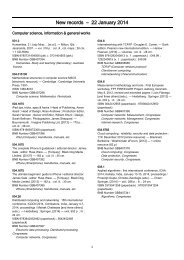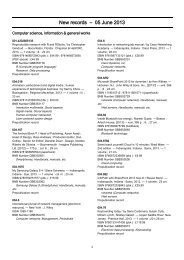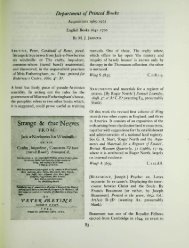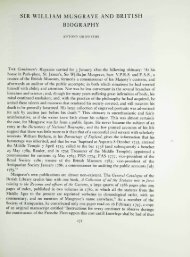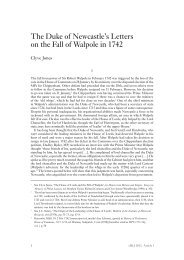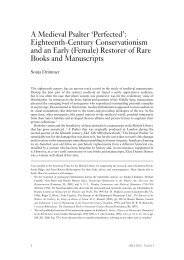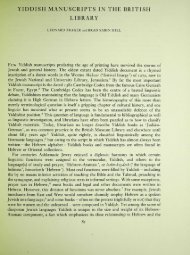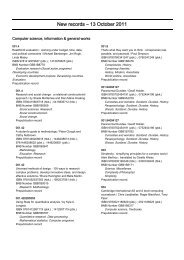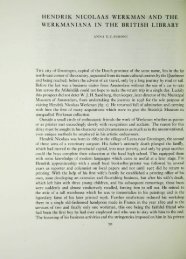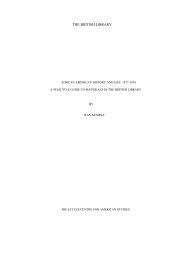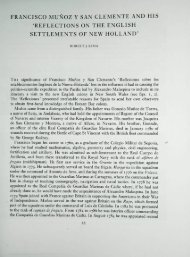Working with the British Library and DataCite A guide for Higher ...
Working with the British Library and DataCite A guide for Higher ...
Working with the British Library and DataCite A guide for Higher ...
You also want an ePaper? Increase the reach of your titles
YUMPU automatically turns print PDFs into web optimized ePapers that Google loves.
<strong>Working</strong> <strong>with</strong> <strong>the</strong><br />
<strong>British</strong> <strong>Library</strong> <strong>and</strong> <strong>DataCite</strong><br />
A <strong>guide</strong> <strong>for</strong> <strong>Higher</strong> Education<br />
Institutions in <strong>the</strong> UK
Contents<br />
About this <strong>guide</strong><br />
This booklet is intended as an introduction to <strong>the</strong> <strong>DataCite</strong> service that UK<br />
organisations can access through <strong>the</strong> <strong>British</strong> <strong>Library</strong>. It provides an overview of<br />
<strong>the</strong> <strong>DataCite</strong> universe <strong>and</strong> in-depth in<strong>for</strong>mation about <strong>the</strong> application of Digital<br />
Object Identifiers (DOIs) to research data. Organisations that are considering<br />
working <strong>with</strong> <strong>DataCite</strong> will find best-practice guidance on how to register <strong>and</strong><br />
manage DOIs <strong>for</strong> <strong>the</strong>ir data, alongside in<strong>for</strong>mation on how to access <strong>the</strong> service<br />
through <strong>the</strong> <strong>British</strong> <strong>Library</strong>.<br />
The in<strong>for</strong>mation presented here has been in<strong>for</strong>med by feedback received from<br />
attendees at a series of workshops on data citation, which took place at <strong>the</strong> <strong>British</strong><br />
<strong>Library</strong> throughout 2012-13. Our work <strong>with</strong> existing <strong>DataCite</strong> clients has also<br />
influenced <strong>the</strong> <strong>guide</strong>.<br />
1 The <strong>British</strong> <strong>Library</strong> <strong>and</strong> <strong>DataCite</strong> 02<br />
2 How does <strong>DataCite</strong> work? 03<br />
Administrative Infrastructure 03<br />
Technical Infrastructure 03<br />
3 Getting Started 05<br />
<strong>DataCite</strong> Checklist 06<br />
Client Responsibilities 06<br />
<strong>British</strong> <strong>Library</strong> Responsibilities 06<br />
4 Using <strong>the</strong> <strong>DataCite</strong> Metadata Store 07<br />
5 L<strong>and</strong>ing Pages 09<br />
Basic elements of a l<strong>and</strong>ing page 09<br />
6 DOI syntax 10<br />
How to construct your suffix 10<br />
7 Guide to <strong>DataCite</strong> Metadata 12<br />
About <strong>the</strong> Schema 12<br />
M<strong>and</strong>atory metadata properties 12<br />
Recommended metadata properties 12<br />
Optional metadata properties 13<br />
Citation Format 13<br />
Metadata openness 13<br />
8 <strong>Working</strong> <strong>with</strong> DOIs 14<br />
Granularity: at what level should you assign DOIs? 14<br />
Dealing <strong>with</strong> multiple versions 16<br />
Embargoed data: when to apply <strong>the</strong> DOI 17<br />
9 Glossary 18<br />
10 Resources <strong>and</strong> References 19<br />
Acknowledgements<br />
Funding <strong>for</strong> <strong>the</strong> creation of this <strong>guide</strong>, <strong>and</strong> <strong>the</strong> workshops<br />
on which it was based, was provided by <strong>the</strong> Jisc Managing<br />
Research Data Programme 2011–13.<br />
We would particularly like to thank Simon Hodson, Manager of <strong>the</strong> MRD<br />
Programme, <strong>and</strong> <strong>the</strong> contributors to <strong>the</strong> workshop series <strong>for</strong> <strong>the</strong>ir support.<br />
01
1 The <strong>British</strong> <strong>Library</strong> <strong>and</strong> <strong>DataCite</strong><br />
2 How does <strong>DataCite</strong> work?<br />
A global plat<strong>for</strong>m <strong>for</strong> UK research data<br />
About <strong>DataCite</strong><br />
<strong>DataCite</strong> is a global network of national libraries, data centres <strong>and</strong> o<strong>the</strong>r research<br />
organisations that works to increase <strong>the</strong> recognition of data as legitimate, citable<br />
contributions to <strong>the</strong> scholarly record.<br />
Data sharing <strong>and</strong> re-use are becoming increasingly central to <strong>the</strong> research process, <strong>and</strong> so<br />
it is vital that we have effective tools to find, access <strong>and</strong> use that data. <strong>DataCite</strong> contributes<br />
to <strong>the</strong> emerging research data infrastructure by providing Digital Object Identifiers (DOIs)<br />
<strong>for</strong> datasets <strong>and</strong> o<strong>the</strong>r non-traditional research outputs. DOI assignment helps to make data<br />
persistently identifiable <strong>and</strong> citable.<br />
In addition, <strong>DataCite</strong> promotes st<strong>and</strong>ards <strong>for</strong> data citation <strong>and</strong> description, <strong>and</strong> through its<br />
network of member organisations, creates an international community of users which helps<br />
establish best-practices <strong>for</strong> <strong>the</strong> citation <strong>and</strong> management of research data.<br />
The <strong>British</strong> <strong>Library</strong>, <strong>DataCite</strong> <strong>and</strong> You<br />
Administrative Infrastructure<br />
As a UK-based <strong>DataCite</strong> client, your relationship is <strong>with</strong> <strong>the</strong><br />
<strong>British</strong> <strong>Library</strong>. The <strong>Library</strong> acts as an intermediary between<br />
your organisation <strong>and</strong> <strong>the</strong> wider <strong>DataCite</strong> infrastructure: a<br />
hierarchy of organisations which provide <strong>the</strong> structure <strong>and</strong><br />
governance that make <strong>DataCite</strong> work.<br />
At <strong>the</strong> top of this hierarchy is <strong>the</strong> International DOI Foundation<br />
(IDF), <strong>the</strong> governing body responsible <strong>for</strong> <strong>the</strong> management of<br />
<strong>the</strong> DOI system worldwide. The IDF provides oversight of its<br />
member bodies, <strong>and</strong> policy <strong>and</strong> guidance in <strong>the</strong> <strong>for</strong>m of <strong>the</strong><br />
DOI H<strong>and</strong>book 3 .<br />
<strong>DataCite</strong> is a member of <strong>the</strong> IDF <strong>and</strong> one of a h<strong>and</strong>ful of<br />
“Registration Agencies” (CrossRef is ano<strong>the</strong>r) which have <strong>the</strong><br />
authority to allocate DOIs. It is <strong>the</strong> only agency that focuses<br />
on identifiers <strong>for</strong> data.<br />
International DOI Foundation (IDF)<br />
As one of <strong>the</strong> largest research libraries in <strong>the</strong> world, <strong>the</strong> <strong>British</strong> <strong>Library</strong> plays a key role in<br />
supporting research excellence in <strong>the</strong> UK.<br />
The <strong>Library</strong> is one of <strong>the</strong> founding members of <strong>DataCite</strong> <strong>and</strong> helps make UK research data<br />
accessible <strong>and</strong> visible to an international audience by providing UK-based organisations <strong>with</strong><br />
<strong>the</strong> ability to mint 1 DOIs <strong>for</strong> <strong>the</strong>ir data. Once signed up to <strong>the</strong> service, clients will have access<br />
to <strong>the</strong> full <strong>DataCite</strong> system, including:<br />
• A simple web interface <strong>for</strong> DOI creation<br />
• The Metadata Store: a centralised, searchable database which makes data easy to find<br />
<strong>and</strong> access<br />
• A global infrastructure <strong>for</strong> data dissemination <strong>and</strong> citation<br />
• Support <strong>and</strong> guidance on <strong>the</strong> best practices <strong>for</strong> data citation.<br />
Digital Object Identifiers (DOIs)<br />
DOIs are persistent identifiers that are used to uniquely identify an object (which itself may<br />
be physical or digital) in <strong>the</strong> digital environment.<br />
Although o<strong>the</strong>r persistent identifiers are available, <strong>DataCite</strong> chose to work <strong>with</strong> DOIs as <strong>the</strong>y<br />
have a number of features that are particularly compatible <strong>with</strong> <strong>the</strong> aims of <strong>the</strong> organisation.<br />
DOIs are:<br />
• Already well-established as identifiers <strong>for</strong> research publications<br />
• Recognised as an ISO st<strong>and</strong>ard 2<br />
• Centrally managed <strong>and</strong> governed by <strong>the</strong> International DOI Foundation (IDF).<br />
<strong>DataCite</strong> operates <strong>the</strong> technical infrastructure (see below) that<br />
enables minting of DOIs <strong>for</strong> data <strong>and</strong> also provides policy <strong>and</strong><br />
operating guidance <strong>for</strong> members.<br />
Under <strong>DataCite</strong>’s distributed model, member organisations<br />
serve regional communities around <strong>the</strong> world. The <strong>British</strong><br />
<strong>Library</strong> is a member <strong>and</strong> “Allocation Agency” <strong>for</strong> <strong>DataCite</strong>,<br />
meaning that we have <strong>the</strong> authority to allocate <strong>DataCite</strong> DOI<br />
prefixes to our clients. We are <strong>the</strong> only Allocation Agency in<br />
<strong>the</strong> UK.<br />
Technical Infrastructure<br />
You<br />
(Data Client)<br />
The <strong>DataCite</strong> system has two key components: <strong>the</strong> Metadata Store, which holds metadata<br />
<strong>for</strong> all DOIs registered by <strong>DataCite</strong> clients, <strong>and</strong> a H<strong>and</strong>le service, through which DOIs can be<br />
resolved by external users.<br />
The <strong>DataCite</strong> Metadata Store (MDS)<br />
The Metadata Store is at <strong>the</strong> heart of what <strong>DataCite</strong> does. It is <strong>the</strong> database which holds <strong>the</strong><br />
metadata <strong>for</strong> all DOIs registered by <strong>DataCite</strong> clients worldwide.<br />
The Metadata Store is centrally maintained by <strong>DataCite</strong>, ensuring secure, stable storage <strong>for</strong><br />
your metadata.<br />
H<strong>and</strong>le Service<br />
The H<strong>and</strong>le System 4 is an established mechanism <strong>for</strong> managing identifiers (“h<strong>and</strong>les”) <strong>for</strong><br />
resources in <strong>the</strong> digital environment.<br />
The system is made up of numerous local h<strong>and</strong>le services, each comprised of one or more<br />
servers on which h<strong>and</strong>les are stored. <strong>DataCite</strong>’s local h<strong>and</strong>le service is hosted by CNRI 5 . An<br />
additional h<strong>and</strong>le service called <strong>the</strong> Global H<strong>and</strong>le Registry holds in<strong>for</strong>mation on <strong>the</strong> unique<br />
h<strong>and</strong>le prefixes from each of <strong>the</strong> local services, meaning that a h<strong>and</strong>le stored on any one of<br />
<strong>the</strong>se services can be located through <strong>the</strong> Global H<strong>and</strong>le Registry.<br />
The <strong>DataCite</strong> h<strong>and</strong>le service maps h<strong>and</strong>les to <strong>the</strong> URLs of l<strong>and</strong>ing pages, so when a user<br />
resolves a given DOI <strong>the</strong>y are redirected to <strong>the</strong> l<strong>and</strong>ing page.<br />
02<br />
1<br />
‘Minting’ is <strong>the</strong> term used to describe <strong>the</strong> registration of a DOI <strong>for</strong> an item of data.<br />
2<br />
ISO 26324:2012 http://www.iso.org/iso/catalogue_detail?csnumber=43506<br />
3<br />
DOI H<strong>and</strong>book http://www.doi.org/hb.html<br />
4<br />
H<strong>and</strong>le System website http://www.h<strong>and</strong>le.net/<br />
5<br />
The Corporation <strong>for</strong> National Research Initiatives http://www.cnri.reston.va.us/<br />
03
3 Getting Started<br />
How does it work?<br />
The key processes carried out by <strong>the</strong> <strong>DataCite</strong> infrastructure are outlined below.<br />
1 When <strong>the</strong> client repository registers or updates a DOI, metadata <strong>and</strong> <strong>the</strong> l<strong>and</strong>ing page<br />
URL are uploaded to <strong>the</strong> <strong>DataCite</strong> Metadata Store.<br />
2 The Metadata Store sends in<strong>for</strong>mation about <strong>the</strong> newly registered DOI <strong>and</strong> related URL to<br />
<strong>the</strong> <strong>DataCite</strong> H<strong>and</strong>le service, mapping each URL to a h<strong>and</strong>le.<br />
3 When users click on a DOI link or enter a DOI into a resolver service 6 , <strong>the</strong> Global H<strong>and</strong>le<br />
Registry automatically redirects <strong>the</strong>m to <strong>the</strong> l<strong>and</strong>ing page of <strong>the</strong> requested DOI.<br />
If you are considering signing up <strong>for</strong> <strong>DataCite</strong> DOIs <strong>with</strong> <strong>the</strong> <strong>British</strong> <strong>Library</strong>, this flowchart<br />
sets out <strong>the</strong> basic pathway to getting started <strong>with</strong> <strong>the</strong> service.<br />
1 Are <strong>DataCite</strong> DOIs right <strong>for</strong> my organisation?<br />
To decide whe<strong>the</strong>r DOIs are <strong>the</strong> right option <strong>for</strong> your organisation <strong>and</strong> <strong>the</strong> data you<br />
hold, you should consider whe<strong>the</strong>r you meet <strong>the</strong> basic requirements set out in <strong>the</strong><br />
<strong>British</strong> <strong>Library</strong>’s <strong>DataCite</strong> Checklist.<br />
There are also some ongoing Responsibilities that all <strong>DataCite</strong> clients must commit to,<br />
so please check that you will be able to fulfil <strong>the</strong>se.<br />
Refer to page 6 <strong>for</strong> fur<strong>the</strong>r details of <strong>the</strong> Checklist <strong>and</strong> Responsibilities<br />
3<br />
DOI resolution<br />
2 Test account (optional)<br />
Client<br />
repository<br />
1<br />
Metadata<br />
2<br />
Store<br />
H<strong>and</strong>le<br />
server<br />
Once you have decided that <strong>DataCite</strong> DOIs are an appropriate solution <strong>for</strong> your<br />
data you have <strong>the</strong> option to find out more be<strong>for</strong>e making a final decision by<br />
requesting access to a test account. A test account allows you to register temporary<br />
DOIs <strong>and</strong> to explore how <strong>the</strong> service fits <strong>with</strong>in your workflows. The Metadata<br />
Store test environment replicates <strong>the</strong> live service almost exactly <strong>and</strong> is a good way<br />
to experiment <strong>with</strong> <strong>the</strong> system <strong>with</strong>out any long term commitment.<br />
Global H<strong>and</strong>le<br />
Registry<br />
H<strong>and</strong>le system<br />
Figure 1 <strong>the</strong> <strong>DataCite</strong> technical infrastructure, showing <strong>the</strong> relationship between <strong>the</strong> Client, <strong>the</strong> Metadata Store,<br />
H<strong>and</strong>le Service <strong>and</strong> End User<br />
<strong>DataCite</strong> DOIs <strong>and</strong> <strong>the</strong> H<strong>and</strong>le system<br />
The DOI system operates on H<strong>and</strong>le technology, but this is only one element of <strong>the</strong> service<br />
that <strong>DataCite</strong> offers.<br />
While <strong>the</strong> H<strong>and</strong>le system provides a secure method of resolution <strong>for</strong> identifiers, <strong>DataCite</strong><br />
adds fur<strong>the</strong>r infrastructure in <strong>the</strong> <strong>for</strong>m of <strong>the</strong> Metadata Store, which securely links a data<br />
object to its description <strong>and</strong> ensures that your data is not only persistently identifiable, it also<br />
remains usable <strong>and</strong> searchable. The DOI system also offers a simple global resolution service<br />
through dx.doi.org.<br />
In addition, <strong>the</strong> governance provided by <strong>the</strong> IDF <strong>and</strong> <strong>DataCite</strong> also means that <strong>the</strong>re<br />
are st<strong>and</strong>ards, policies <strong>and</strong> <strong>guide</strong>lines in place to ensure that DOIs function as persistent<br />
identifiers <strong>for</strong> data, allowing <strong>the</strong>m to be cited <strong>with</strong> confidence.<br />
3 Contract <strong>and</strong> Costs<br />
The next step is to enter into a contract <strong>with</strong> <strong>the</strong> <strong>British</strong> <strong>Library</strong>. Contracts are <strong>for</strong><br />
an initial term of three years; a period that indicates a level of commitment from<br />
both parties.<br />
Institutions are charged a fixed annual fee which allows <strong>the</strong>m to register an<br />
unlimited number of DOIs.<br />
4 Implementing <strong>DataCite</strong> DOIs<br />
Once <strong>the</strong> contract is agreed we will provide you <strong>with</strong> a Metadata Store account<br />
<strong>and</strong> unique DOI prefix so that you can begin minting DOIs <strong>for</strong> your data.<br />
The rest of this <strong>guide</strong> provides detailed in<strong>for</strong>mation on how to work <strong>with</strong><br />
<strong>DataCite</strong> DOIs.<br />
04<br />
6<br />
http://dx.doi.org/ is <strong>the</strong> global resolver maintained by <strong>the</strong> IDF.<br />
05
4 Using <strong>the</strong> <strong>DataCite</strong> Metadata Store<br />
<strong>DataCite</strong> Checklist<br />
Any organisation wishing to register <strong>DataCite</strong> DOIs through <strong>the</strong> <strong>British</strong> <strong>Library</strong> must meet <strong>the</strong><br />
following conditions:<br />
• You have <strong>the</strong> authority to assign DOIs to your data<br />
If you do not own <strong>the</strong> data you must have permission from <strong>the</strong> data owner/creator to<br />
assign DOIs.<br />
• You can guarantee data persistence<br />
Be<strong>for</strong>e signing up <strong>with</strong> <strong>the</strong> <strong>British</strong> <strong>Library</strong>, you will be asked to demonstrate a commitment<br />
to maintaining your data in an accessible <strong>and</strong> usable <strong>for</strong>m <strong>for</strong> <strong>the</strong> long term.<br />
• The data is accessible to external users<br />
The central aim of <strong>DataCite</strong> is to make research data citable, <strong>the</strong>re<strong>for</strong>e DOIs are not<br />
suitable <strong>for</strong> data that is completely unavailable to users outside your institution.<br />
We underst<strong>and</strong> that, <strong>for</strong> certain types of data, it may be necessary to impose access<br />
restrictions or embargoes. In such cases, in<strong>for</strong>mation about how to obtain <strong>and</strong> use <strong>the</strong> data<br />
should be made clear at <strong>the</strong> point of access (i.e. <strong>the</strong> l<strong>and</strong>ing page).<br />
• The data has citation potential<br />
In o<strong>the</strong>r words, it is likely to be of interest to o<strong>the</strong>r researcher/users <strong>and</strong> may be cited in<br />
future works.<br />
Once you have signed up <strong>with</strong> <strong>the</strong> <strong>British</strong> <strong>Library</strong>, we will provide you <strong>with</strong> a Metadata Store<br />
account which allows you to mint <strong>and</strong> manage DOIs <strong>for</strong> your data.<br />
There are three primary tasks that you can per<strong>for</strong>m through <strong>the</strong> Metadata Store user<br />
interface (Fig. 2):<br />
Client Responsibilities<br />
As a <strong>British</strong> <strong>Library</strong> <strong>DataCite</strong> client, you agree to undertake <strong>the</strong> following tasks on an ongoing<br />
basis:<br />
• Provide <strong>and</strong> maintain at least <strong>DataCite</strong> m<strong>and</strong>atory metadata <strong>for</strong> each data item <strong>with</strong> a DOI<br />
• Make metadata openly available <strong>with</strong>out restriction (under Creative Commons Zero<br />
CC0 7 waiver)<br />
• Maintain publicly accessible l<strong>and</strong>ing pages <strong>for</strong> each item <strong>with</strong> a DOI.<br />
<strong>DataCite</strong> client requirements <strong>and</strong> responsibilities are fully detailed in <strong>the</strong> Business Models<br />
Principles 8 document.<br />
<strong>British</strong> <strong>Library</strong> Responsibilities<br />
When you sign a contract <strong>with</strong> <strong>the</strong> <strong>British</strong> <strong>Library</strong> to use <strong>the</strong> <strong>DataCite</strong> service, you can expect<br />
us to fulfil a range of responsibilities which help safeguard <strong>the</strong> persistence of your DOIs. We<br />
guarantee to:<br />
• Maintain our membership of <strong>DataCite</strong> through payment of an annual subscription fee<br />
• Issue a unique DOI prefix <strong>for</strong> your organisation<br />
• Provide you <strong>with</strong> a Metadata Store account, allowing you to mint <strong>and</strong> manage your DOIs<br />
through both <strong>the</strong> user interface <strong>and</strong> API<br />
• Provide support <strong>and</strong> advice on using <strong>the</strong> service, as required<br />
• Work collaboratively <strong>with</strong> you to improve <strong>the</strong> service <strong>and</strong> develop new functionality.<br />
Figure 2 The Metadata Store user interface<br />
1 Mint a DOI<br />
The primary task, minting a DOI <strong>for</strong> an individual dataset, can be done through <strong>the</strong><br />
Metadata Store user interface.<br />
To register a DOI <strong>for</strong> an individual item you will need:<br />
• Metadata (in xml <strong>for</strong>mat)<br />
• URL of its l<strong>and</strong>ing page<br />
• DOI name that you wish to register (see DOI syntax).<br />
When logged into your MDS account, you will find a “Register new dataset” option which<br />
allows you to enter <strong>the</strong> DOI <strong>and</strong> URL <strong>and</strong> to upload your metadata file. By clicking ‘save’ you<br />
have successfully registered a DOI.<br />
Upload<br />
metadata <strong>and</strong><br />
request DOI<br />
Metadata Store<br />
DOI is<br />
registered<br />
A record in <strong>the</strong> Metadata<br />
Store consists of:<br />
DOI<br />
+<br />
URL<br />
+<br />
Metadata<br />
06<br />
7<br />
Creative Commons Zero (CC0) http://creativecommons.org/about/cc0<br />
8<br />
<strong>DataCite</strong> Business Models Principles<br />
http://www.datacite.org/sites/default/files/Business_Models_Principles<br />
User Data<br />
Centre<br />
Figure 3 Minting of a DOI in <strong>the</strong> Metadata Store<br />
07
5 L<strong>and</strong>ing Pages<br />
2 Update metadata<br />
Although <strong>the</strong> five m<strong>and</strong>atory properties cannot be changed, all o<strong>the</strong>r properties may be<br />
amended by uploading a new metadata record to <strong>the</strong> original DOI.<br />
The MDS retains all versions of <strong>the</strong> metadata <strong>and</strong> records <strong>the</strong> version number, making it easy<br />
to track <strong>the</strong> history of your data.<br />
3 Update URL associated <strong>with</strong> an existing DOI<br />
If <strong>the</strong> location of <strong>the</strong> l<strong>and</strong>ing page changes, <strong>the</strong> new URL must be registered in <strong>the</strong> MDS to<br />
ensure that users resolving <strong>the</strong> DOI are directed to <strong>the</strong> correct target.<br />
More in<strong>for</strong>mation: You can view screencasts of <strong>the</strong> basic Metadata Store processes on <strong>the</strong><br />
<strong>British</strong> <strong>Library</strong>’s webpages 9 .<br />
Using <strong>the</strong> API<br />
If you have a large number of datasets, it is possible to semi-automate <strong>the</strong> minting process<br />
by using <strong>the</strong> application programming interface (API). This means that you can integrate <strong>the</strong><br />
minting process into your own systems. For details of how to use <strong>the</strong> API, please visit our<br />
online resource 10 .<br />
Making your data visible<br />
Registering your data in <strong>the</strong> Metadata Store makes it easier to locate <strong>and</strong> access in a number<br />
of different ways.<br />
The Metadata Store can be searched directly through <strong>the</strong> <strong>DataCite</strong> search page 11 which<br />
returns links to data l<strong>and</strong>ing pages. It can also be queried through <strong>the</strong> API, which allows <strong>for</strong><br />
more tailored search <strong>and</strong> <strong>the</strong> option to return <strong>the</strong> results in a variety of <strong>for</strong>mats, including<br />
xml, csv <strong>and</strong> json.<br />
Fur<strong>the</strong>rmore, metadata is made available in OAI-PMH 12 <strong>for</strong>mat, which is <strong>the</strong> st<strong>and</strong>ard<br />
mechanism <strong>for</strong> repository interoperability. Both <strong>the</strong> API <strong>and</strong> OAI-PMH provider mean that<br />
<strong>the</strong> contents of <strong>the</strong> metadata store are available <strong>for</strong> search <strong>and</strong> harvesting by external<br />
services.<br />
The web page that a DOI resolves to is called <strong>the</strong> l<strong>and</strong>ing page. The role of <strong>the</strong> l<strong>and</strong>ing<br />
page is to provide <strong>the</strong> user <strong>with</strong> in<strong>for</strong>mation about <strong>the</strong> data <strong>and</strong> how it can be accessed. It is<br />
<strong>the</strong>re<strong>for</strong>e essential that l<strong>and</strong>ing pages are publicly available <strong>with</strong> no barriers to access (such as<br />
registration). Each item <strong>with</strong> a DOI must have a l<strong>and</strong>ing page 13 .<br />
The URL of <strong>the</strong> l<strong>and</strong>ing page is uploaded to <strong>the</strong> Metadata Store at <strong>the</strong> point of DOI<br />
registration <strong>and</strong> should be updated by <strong>the</strong> client if it changes.<br />
The l<strong>and</strong>ing page should display up-to-date in<strong>for</strong>mation about <strong>the</strong> data <strong>and</strong> access/use<br />
conditions.<br />
Basic elements of a l<strong>and</strong>ing page<br />
The l<strong>and</strong>ing page must contain at least <strong>the</strong> following in<strong>for</strong>mation:<br />
• The DOI<br />
Prominently displayed to encourage users to cite <strong>the</strong> resource correctly.<br />
• M<strong>and</strong>atory metadata<br />
This provides basic in<strong>for</strong>mation about <strong>the</strong> resource <strong>and</strong> its provenance. We suggest that<br />
you also include this in<strong>for</strong>mation in <strong>the</strong> <strong>for</strong>m of <strong>the</strong> full citation <strong>for</strong> <strong>the</strong> data.<br />
For in<strong>for</strong>mation on <strong>DataCite</strong>’s recommended citation <strong>for</strong>mat, please see Section 7 of<br />
this <strong>guide</strong>.<br />
• In<strong>for</strong>mation about how to access <strong>the</strong> data<br />
This should include details of any access restrictions or registration requirements.<br />
Users should be able to ascertain basic in<strong>for</strong>mation about <strong>the</strong> nature of <strong>the</strong> data <strong>and</strong> its<br />
purpose from <strong>the</strong> l<strong>and</strong>ing page. There<strong>for</strong>e, we recommend that you should include as much<br />
relevant descriptive metadata as possible; <strong>for</strong> example related resources, abstract or dates of<br />
creation.<br />
You should also include any in<strong>for</strong>mation necessary <strong>for</strong> <strong>the</strong> user to interpret or use <strong>the</strong> data.<br />
For example, specific software required to render <strong>the</strong> data accurately.<br />
L<strong>and</strong>ing Pages key points:<br />
• Each DOI should resolve to a l<strong>and</strong>ing page<br />
• L<strong>and</strong>ing pages are open<br />
• L<strong>and</strong>ing pages provide in<strong>for</strong>mation about how to access <strong>and</strong> use <strong>the</strong> data<br />
• Even data that is no longer accessible must have a l<strong>and</strong>ing page.<br />
More in<strong>for</strong>mation: you can view a selection of best-practice l<strong>and</strong>ing pages on <strong>the</strong> <strong>British</strong><br />
<strong>Library</strong> website at http://www.bl.uk/datasets.<br />
9<br />
Metadata Store screencasts<br />
http://www.bl.uk/aboutus/stratpolprog/digi/datasets/datacitefaq/faqhome.html<br />
10<br />
API documentation https://mds.datacite.org/static/apidoc<br />
11<br />
Metadata Store search http://search.datacite.org/ui<br />
12<br />
Open Archives Initiative Protocol <strong>for</strong> Metadata Harvesting (OAI-PMH)<br />
08<br />
http://www.openarchives.org/pmh/<br />
13 <br />
In some cases, it may be appropriate <strong>for</strong> multiple DOIs to resolve to <strong>the</strong> same l<strong>and</strong>ing page, <strong>for</strong><br />
example collections of data or data <strong>with</strong> multiple versions.<br />
09
6 DOI Syntax<br />
A DOI name consists of a prefix <strong>and</strong> suffix separated by a <strong>for</strong>ward slash.<br />
10.1234/5678abcd<br />
prefix suffix<br />
Upon signing up to <strong>the</strong> <strong>DataCite</strong> service, each organisation is assigned a unique prefix. The<br />
<strong>for</strong>mat of <strong>the</strong> suffix is chosen by each organisation <strong>with</strong> only a few restrictions on syntax.<br />
How to construct your suffix<br />
The most important property of a DOI suffix is that it should be unique <strong>with</strong>in<br />
<strong>the</strong> given prefix space. The <strong>DataCite</strong> system will reject any attempt to mint<br />
duplicate DOIs.<br />
Examples of <strong>DataCite</strong> suffixes<br />
Below are some DOIs from existing <strong>DataCite</strong> clients which demonstrate <strong>the</strong> diversity of suffix<br />
structures currently in use.<br />
Archaeology Data Service: 10.5284/1000141<br />
Suffix chosen from a numerical sequence<br />
NERC (BODC):<br />
10.5285/AD314FA1-7118-11E2-938C-1803734A77FB<br />
R<strong>and</strong>omly generated string<br />
UK Data Service: 10.5255/UKDA-SN-6918-2<br />
10.5255/UKDA-SN-6918-1<br />
UKDS (<strong>for</strong>merly <strong>the</strong> UK Data Archive, UKDA) suffixes contain <strong>the</strong> organisation name, <strong>the</strong><br />
study number (6918) <strong>and</strong> <strong>the</strong> version number (1, 2)<br />
Please consider <strong>the</strong> following points when creating your suffixes:<br />
• We suggest that <strong>the</strong> optimum suffix length is 8-10 characters<br />
This is long enough to ensure uniqueness but short enough to avoid typing or<br />
text-wrapping errors. Please note that <strong>the</strong> <strong>DataCite</strong> system will not accept DOI<br />
strings of more than 255 characters.<br />
• DOIs are not case-sensitive<br />
In o<strong>the</strong>r words 10.1234/ABCD <strong>and</strong> 10.1234/abcd are <strong>the</strong> same DOI.<br />
• We strongly recommend that only <strong>the</strong> following characters are used <strong>with</strong>in a DOI<br />
name: “0-9”, “A-Z” <strong>and</strong> “- . _ /”<br />
Although <strong>the</strong> DOI name itself can accommodate a wider range of characters,<br />
some require encoding so that <strong>the</strong> DOI works correctly when used in URL<br />
<strong>for</strong>m. If you need to use additional characters, please take care to follow <strong>the</strong><br />
recommendations on encoding provided by <strong>the</strong> IDF 14 .<br />
Opaque vs. in<strong>for</strong>mational suffixes<br />
Some data centres choose to use <strong>the</strong> suffix to convey in<strong>for</strong>mation about <strong>the</strong> data that it<br />
represents. For example, <strong>the</strong> suffix could include a version number or local identifier to aid<br />
human recognition or to reflect some kind of hierarchy <strong>with</strong>in <strong>the</strong> repository.<br />
Please note, however, that <strong>the</strong> DOI system treats DOI names as opaque (i.e. “dumb<br />
numbers” which do not convey any in<strong>for</strong>mation) <strong>and</strong> cannot interpret any meaning in your<br />
choice of suffix. Any in<strong>for</strong>mation you choose to embed in <strong>the</strong> suffix should be <strong>for</strong> your<br />
internal use only.<br />
You should also bear in mind that DOIs are designed to remain persistent over <strong>the</strong> long term<br />
<strong>and</strong> any meaning you embed in <strong>the</strong> DOI may not make sense to future users.<br />
10<br />
14<br />
DOI H<strong>and</strong>book Section 2.5: Characters <strong>and</strong> Encoding<br />
http://www.doi.org/doi_h<strong>and</strong>book/2_Numbering.html#2.5<br />
11
7 Guide to <strong>DataCite</strong> Metadata<br />
Metadata is an integral part of <strong>the</strong> <strong>DataCite</strong> system. By associating good quality metadata<br />
<strong>with</strong> a DOI in <strong>the</strong> Metadata Store, your data is made more visible, accessible <strong>and</strong> usable.<br />
<strong>DataCite</strong> provides a metadata schema that was designed <strong>for</strong> use <strong>with</strong> datasets <strong>and</strong> o<strong>the</strong>r<br />
non-traditional research outputs.<br />
About <strong>the</strong> Schema<br />
The <strong>DataCite</strong> Metadata Schema 15 is a list of core elements which were chosen to support <strong>the</strong><br />
citation <strong>and</strong> retrieval of data. Some key benefits of <strong>the</strong> <strong>DataCite</strong> Schema are:<br />
• It <strong>for</strong>ms <strong>the</strong> basis <strong>for</strong> a recommended st<strong>and</strong>ard citation <strong>for</strong>mat <strong>for</strong> datasets (see page 13)<br />
• It is interoperable <strong>with</strong> o<strong>the</strong>r data management schemas, such as Dublin Core<br />
• It can accommodate numerous types of data<br />
• Its development is overseen by a <strong>Working</strong> Group composed of <strong>DataCite</strong> members,<br />
allowing <strong>the</strong> schema to evolve in response to feedback from <strong>DataCite</strong> clients.<br />
The schema consists of five m<strong>and</strong>atory properties plus a range of recommended/optional<br />
properties that may be used to describe <strong>and</strong> identify your data more fully. These can be<br />
fur<strong>the</strong>r refined through <strong>the</strong> use of sub-properties.<br />
M<strong>and</strong>atory metadata properties<br />
The following properties must be provided when you register a DOI.<br />
Identifier<br />
sub-property: identifierType<br />
Title<br />
Creator<br />
sub-property: creatorName<br />
Publisher<br />
PublicationYear<br />
The only allowed value <strong>for</strong> identiferType is “DOI”<br />
A descriptive name <strong>for</strong> <strong>the</strong> resource<br />
The author or producer of <strong>the</strong> data. There may be<br />
multiple Creators, in which case <strong>the</strong>y should be listed<br />
in order of priority<br />
The data holder. This is usually <strong>the</strong> repository or data<br />
centre in which <strong>the</strong> data is stored<br />
The year when <strong>the</strong> data was (or will be) made publicly<br />
available.<br />
Once registered, <strong>the</strong> m<strong>and</strong>atory metadata cannot be changed, so care must be taken to<br />
ensure that it is free of errors.<br />
Recommended metadata properties<br />
(sub-properties are specified only where <strong>the</strong>y are required)<br />
There is a fur<strong>the</strong>r tier of properties that, while not compulsory, are recommended to increase<br />
<strong>the</strong> visibility <strong>and</strong> usability of your content. These are:<br />
Subject<br />
Contributor (sub-properties: contributorType, contributorName)<br />
Date (sub-property: dateType)<br />
ResourceType (sub-property: resourceTypeGeneral)<br />
RelatedIdentifier (sub-properties: relatedIdentifierType, relationType)<br />
Description (sub-property: descriptionType)<br />
GeoLocation<br />
Optional metadata properties<br />
A final series of properties can be applied to fur<strong>the</strong>r refine <strong>the</strong> description of your data.<br />
Language<br />
AlternateIdentifier (sub-property: alternateIdentifierType)<br />
Size<br />
Format<br />
Version<br />
Rights<br />
Not all of <strong>the</strong>se properties will be relevant to all data (<strong>for</strong> example you may not have<br />
GeoLocation or RelatedIdentifier in<strong>for</strong>mation <strong>for</strong> all data) but, if you hold this in<strong>for</strong>mation<br />
about your data, we strongly recommend that you include it in <strong>the</strong> metadata record.<br />
Citation Format<br />
The five m<strong>and</strong>atory properties <strong>for</strong>m <strong>the</strong> basis of <strong>the</strong> recommended st<strong>and</strong>ard citation<br />
<strong>for</strong>mat:<br />
Creator (PublicationYear): Title. Publisher. Identifier<br />
Where possible, we recommend that you should also include <strong>the</strong> “Version” <strong>and</strong><br />
“ResourceType” properties in your metadata to ensure that your resources are easily<br />
identifiable. The exp<strong>and</strong>ed recommended citation <strong>for</strong>mat <strong>the</strong>n becomes:<br />
Creator (PublicationYear): Title. Version. Publisher. ResourceType. Identifier<br />
Please note that this is a recommended <strong>for</strong>mat only. You may choose to use any<br />
<strong>for</strong>mat that meets your needs or is required by <strong>the</strong> publisher.<br />
Metadata openness<br />
The <strong>British</strong> <strong>Library</strong> requires that all metadata held in <strong>the</strong> Metadata Store is published<br />
under a Creative Commons Zero (CC0) waiver, meaning that it may be freely re-used <strong>for</strong><br />
any purpose. This ensures that <strong>the</strong> metadata is fully searchable <strong>and</strong> removes barriers to<br />
interoperability <strong>with</strong> o<strong>the</strong>r systems.<br />
If you are unable to share even <strong>the</strong> m<strong>and</strong>atory metadata <strong>for</strong> your data under CC0, <strong>the</strong>n <strong>the</strong><br />
data is unlikely to be suitable <strong>for</strong> sharing <strong>and</strong> citation, <strong>and</strong> so a <strong>DataCite</strong> DOI is unnecessary.<br />
<strong>DataCite</strong> Metadata: key points<br />
• Metadata (at least <strong>the</strong> m<strong>and</strong>atory fields) must be provided at <strong>the</strong> time of DOI<br />
registration<br />
• The Metadata Store will only accept metadata in xml <strong>for</strong>mat<br />
• M<strong>and</strong>atory metadata fields are fixed at <strong>the</strong> point of registration <strong>and</strong> cannot<br />
be updated<br />
• Optional/recommended metadata fields may be updated or added to as required<br />
• Metadata is open under CC0.<br />
12<br />
15<br />
All in<strong>for</strong>mation relates to version 3.0 of <strong>the</strong> Schema, which was released in August 2013<br />
http://schema.datacite.org/<br />
13
8 <strong>Working</strong> <strong>with</strong> DOIs<br />
Deciding how to allocate DOIs to content is one of <strong>the</strong> first issues to be addressed by new<br />
<strong>DataCite</strong> users. Research data takes many <strong>for</strong>ms <strong>and</strong> is not always presented in clearly<br />
defined ‘units’. This means that assigning identifiers to data so that it is usable, meaningful<br />
<strong>and</strong> manageable can be challenging.<br />
The key questions when considering how to implement DOIs <strong>for</strong> your data can be<br />
summarised as:<br />
Hierarchical data<br />
Just as publications have identifiers at different levels of hierarchy (journal > article > section),<br />
some types of data may have similar relationships that it is useful to record. For example, a<br />
group of related items may exist at collection > study > file levels.<br />
Relationships between items in a hierarchy may be expressed in <strong>DataCite</strong> metadata using <strong>the</strong><br />
RelatedIdentifier property:<br />
WHAT should you assign <strong>the</strong> DOI to?<br />
• What can be considered a ‘meaningful’ unit of<br />
data? (see Granularity)<br />
• What level of data change triggers a new DOI<br />
(see Dealing <strong>with</strong> multiple versions)<br />
WHEN should you mint <strong>the</strong> DOI?<br />
• Upon deposit or publication?<br />
• Dealing <strong>with</strong> data embargoes<br />
<br />
10.1234/subDOI1<br />
10.1234/subDOI2<br />
<br />
<br />
<strong>DataCite</strong> does not impose strict rules <strong>with</strong> respect to <strong>the</strong>se issues <strong>and</strong> recognises that<br />
practices vary by discipline. However, <strong>the</strong>re are a few general principles that should <strong>guide</strong><br />
you when establishing institutional policies <strong>for</strong> DOI allocation.<br />
Granularity: at what level should you assign DOIs?<br />
The level of granularity at which DOIs are applied is determined by <strong>the</strong> individual data centre.<br />
When deciding upon <strong>the</strong> most appropriate level you should consider <strong>the</strong> following:<br />
• The current citation <strong>and</strong> research practices among your user community: what is likely to<br />
be cited?<br />
• The needs of various stakeholders: how will funders/publishers/administrators/etc. use <strong>the</strong><br />
data?<br />
• The type of resource: <strong>for</strong> example, a complex dataset may require a more granular<br />
identifier structure than a document or image file<br />
• Sustainability: you must be able to maintain each item <strong>with</strong> a DOI in accordance <strong>with</strong><br />
<strong>DataCite</strong> client Responsibilities.<br />
With respect to this last point, <strong>the</strong> only <strong>DataCite</strong> <strong>and</strong> <strong>British</strong> <strong>Library</strong> requirements relevant to<br />
your choice of data granularity are that you must be able to provide meaningful metadata<br />
<strong>and</strong> a l<strong>and</strong>ing page <strong>for</strong> each item <strong>with</strong> a DOI.<br />
If you cannot meet <strong>the</strong>se basic requirements <strong>for</strong> each item that you want to assign a DOI to,<br />
you might consider using internal identifiers <strong>for</strong> lower-level data identification.<br />
Expressing relationships between content items<br />
Relationships between items can be encapsulated in <strong>the</strong> metadata using <strong>the</strong> RelatedIdentifer<br />
field. The relationType attribute of this property allows <strong>the</strong> precise nature of <strong>the</strong> relationship<br />
to be specified. Relevant allowed values include isPartOf, hasPart, isSupplementTo <strong>and</strong><br />
isSupplementedBy 16 .<br />
Aggregate data<br />
Objects stored separately can be placed in logical collections by applying an ‘umbrella DOI’<br />
over individual components.<br />
Figure 4 Excerpt of metadata of <strong>the</strong> lower level data object in a hierarchy<br />
<br />
10.1234/umbrellaDOI<br />
<br />
<br />
Figure 5 Excerpt of metadata of <strong>the</strong> lower level data object in a hierarchy<br />
Linking to external items<br />
You can also use <strong>the</strong> RelatedIdentifier property to link a dataset to a related publication, or<br />
any o<strong>the</strong>r item, both <strong>with</strong>in <strong>the</strong> Metadata Store or elsewhere.<br />
Again, <strong>the</strong> nature of <strong>the</strong> relationship between <strong>the</strong> items can be described using <strong>the</strong><br />
relationType property. Relevant allowed values include IsCitedBy, Cites, IsReferencedBy,<br />
References, IsDocumentedBy <strong>and</strong> Documents.<br />
For example, a dataset that <strong>for</strong>ms <strong>the</strong> basis of a published article may contain a link to <strong>the</strong><br />
publication via its DOI:<br />
<br />
10.1234/articleDOI<br />
<br />
<br />
Figure 6 Excerpt of metadata of a data object which has been cited in a publication<br />
Note that <strong>the</strong> RelatedIdentifier field can accommodate many identifier types (not just DOIs),<br />
so you may link to content that is identified by, <strong>for</strong> example, URN, ARK or ISSN. Refer to <strong>the</strong><br />
schema <strong>for</strong> <strong>the</strong> full controlled list.<br />
14<br />
16<br />
Refer to <strong>the</strong> schema <strong>for</strong> <strong>the</strong> full list of allowed values http://schema.datacite.org/<br />
15
Data <strong>with</strong> multiple access or use conditions<br />
Having a greater level of granularity allows <strong>for</strong> greater flexibility <strong>and</strong> control over your data.<br />
For example, if a subset of a dataset contains confidential in<strong>for</strong>mation, you can allocate<br />
a separate DOI to this subset so that access restrictions can be imposed while leaving <strong>the</strong><br />
remainder of <strong>the</strong> dataset open.<br />
Dealing <strong>with</strong> multiple versions<br />
It is best practice to issue a new DOI when an item changes. Bear in mind that <strong>the</strong> original<br />
DOI may have been cited <strong>and</strong> <strong>the</strong> item reused, <strong>with</strong> published work based on it. Changing<br />
<strong>the</strong> data may undermine that work. So it is important to ensure that, when <strong>the</strong> DOI is<br />
accessed in <strong>the</strong> future, new users are able to exactly replicate work based on it. If you assign<br />
a new DOI to updated items, this issue can be avoided.<br />
If a dataset undergoes a change requiring a new DOI to be issued, <strong>the</strong> Version property<br />
allows <strong>the</strong> update to be recorded. You can also link to previous/subsequent versions using<br />
<strong>the</strong> RelatedIdentifier property.<br />
Very minor changes (such as <strong>the</strong> correction of a typing error that does not affect <strong>the</strong><br />
meaning or au<strong>the</strong>nticity of <strong>the</strong> resource) may, at <strong>the</strong> discretion of <strong>the</strong> data holder, be made<br />
<strong>with</strong>out issuing a new DOI. Please contact us if you are unsure about how to deal <strong>with</strong><br />
changes to your data.<br />
<br />
10.1234/earlierversionDOI<br />
<br />
<br />
2<br />
<br />
Embargoed data: when to apply <strong>the</strong> DOI<br />
In cases when data can’t be made accessible immediately upon deposit in <strong>the</strong> repository, it<br />
may be unclear when <strong>the</strong> most appropriate time to register <strong>the</strong> DOI is. While this depends<br />
largely on <strong>the</strong> policies <strong>and</strong> workflows of your repository, <strong>the</strong> following pros <strong>and</strong> cons may<br />
help you make your decision:<br />
DOI on<br />
embargo<br />
end date<br />
DOI on<br />
deposit<br />
Pros<br />
No risk of revealing sensitive<br />
in<strong>for</strong>mation<br />
Record of <strong>the</strong> data exists in <strong>the</strong><br />
Metadata Store<br />
Data creator can cite <strong>the</strong>ir own data<br />
The l<strong>and</strong>ing page <strong>and</strong> metadata can<br />
provide in<strong>for</strong>mation on release date<br />
<strong>for</strong> external users<br />
Cons<br />
More difficult to cite data while<br />
under embargo<br />
Lack of publicly available<br />
in<strong>for</strong>mation about <strong>the</strong> data<br />
Metadata could reveal too much<br />
in<strong>for</strong>mation<br />
Data may change significantly<br />
between creation <strong>and</strong> embargo<br />
end date<br />
If you choose to mint a DOI <strong>for</strong> data that is not yet available <strong>for</strong> use, please remember that<br />
you must provide a l<strong>and</strong>ing page <strong>with</strong> in<strong>for</strong>mation about <strong>the</strong> embargo <strong>and</strong>, preferably, <strong>the</strong><br />
date when <strong>the</strong> data is likely to become available.<br />
Figure 7 Metadata excerpt from a data object <strong>with</strong> an earlier version<br />
Dynamic resources<br />
Resources that undergo regular or ongoing changes (such as longitudinal data) require<br />
a strict versioning policy to ensure that users are served <strong>with</strong> <strong>the</strong> most recent or relevant<br />
dataset.<br />
Depending on <strong>the</strong> nature of <strong>the</strong> resource, you may take a snapshot or slices approach 17 to<br />
versioning, <strong>with</strong> a new DOI issued <strong>for</strong> each snapshot or slice <strong>and</strong> clear in<strong>for</strong>mation about<br />
what in<strong>for</strong>mation is being presented <strong>and</strong> how it relates to o<strong>the</strong>r versions.<br />
The schema also permits <strong>the</strong> citation of a continuously evolving dataset. In this case, you<br />
should add an access date <strong>and</strong> time to <strong>the</strong> citation to give users as much in<strong>for</strong>mation as<br />
possible about <strong>the</strong> resource at <strong>the</strong> time it was used. We urge caution <strong>with</strong> this approach as,<br />
inevitably, when someone tries to access <strong>the</strong> data <strong>with</strong> this DOI in future, <strong>the</strong>y will no<br />
longer be able to use <strong>the</strong> data as cited.<br />
16<br />
17<br />
Ball, A. & Duke, M. (2012). ‘How to Cite Datasets <strong>and</strong> Link to Publications’. DCC How-to Guides.<br />
Edinburgh: Digital Curation Centre. Available online: http://www.dcc.ac.uk/resources/how-<strong>guide</strong>s<br />
17
9 Glossary<br />
10 Resources <strong>and</strong> References<br />
Allocating Agent<br />
A <strong>DataCite</strong> member organisation that provides access to <strong>the</strong> DOI system <strong>for</strong> clients.<br />
API (Application Programming Interface)<br />
A set of routines, protocols, <strong>and</strong> tools <strong>for</strong> building software applications. An API acts as an<br />
interface between software components, allowing <strong>the</strong>m to communicate directly.<br />
Content resolver<br />
A service that exposes <strong>the</strong> metadata stored in <strong>the</strong> <strong>DataCite</strong> Metadata Store in multiple<br />
<strong>for</strong>mats. It can also redirect to content hosted by <strong>DataCite</strong> participating data centres, making<br />
it possible to access data directly using a DOI.<br />
Data Centre<br />
Any organisation that takes responsibility <strong>for</strong> <strong>the</strong> storage, management <strong>and</strong> curation of data.<br />
Data object<br />
A resource to which a DOI can be assigned.<br />
DOI (Digital Object Identifier)<br />
A type of persistent identifier used to uniquely identify an object (which itself may be<br />
physical or digital) in <strong>the</strong> digital environment.<br />
Domain name<br />
An identification string that defines a realm of administrative autonomy, authority, or control<br />
on <strong>the</strong> Internet. E.g. “mywebsite.ac.uk”<br />
H<strong>and</strong>le System<br />
An infrastructure <strong>for</strong> <strong>the</strong> assignment, management <strong>and</strong> resolution of persistent identifiers<br />
(“h<strong>and</strong>les”) <strong>for</strong> digital resources in a network environment (such as <strong>the</strong> Internet). The DOI<br />
system is an implementation of <strong>the</strong> H<strong>and</strong>le System.<br />
International DOI Foundation (IDF)<br />
The international not-<strong>for</strong>-profit organisation that provides governance <strong>and</strong> management of<br />
<strong>the</strong> DOI system.<br />
L<strong>and</strong>ing page<br />
The publicly accessible web page to which a DOI resolves. The l<strong>and</strong>ing page should contain<br />
metadata <strong>and</strong> access in<strong>for</strong>mation about <strong>the</strong> object represented by <strong>the</strong> DOI.<br />
Metadata Store<br />
The database established <strong>and</strong> maintained by <strong>DataCite</strong> to act as a repository <strong>for</strong> metadata<br />
associated <strong>with</strong> <strong>DataCite</strong> DOI minting.<br />
Mint/minting<br />
The term used to describe <strong>the</strong> registration of a DOI <strong>for</strong> a data object by uploading metadata<br />
<strong>and</strong> l<strong>and</strong>ing page in<strong>for</strong>mation to <strong>the</strong> Metadata Store. i.e. to “mint a DOI”.<br />
Persistent identifier<br />
Generic term <strong>for</strong> a type of identifier that will continue to point to a resource even if <strong>the</strong><br />
location of that resource changes.<br />
Registration Agency<br />
A member of <strong>the</strong> IDF that offers services <strong>for</strong> <strong>the</strong> registration of prefixes <strong>and</strong> DOI names using<br />
<strong>the</strong> DOI system. <strong>DataCite</strong> is a Registration Agency.<br />
Using <strong>DataCite</strong> DOIs<br />
<strong>DataCite</strong><br />
http://www.datacite.org/<br />
<strong>DataCite</strong> Schemas Repository<br />
http://schema.datacite.org/<br />
Metadata Search<br />
http://search.datacite.org/ui<br />
API documentation<br />
https://mds.datacite.org/static/apidoc<br />
Business Models Principles<br />
http://www.datacite.org/sites/default/files/Business_Models_Principles_v1.0.pdf<br />
<strong>British</strong> <strong>Library</strong>: In<strong>for</strong>mation <strong>for</strong> potential <strong>DataCite</strong> clients<br />
http://www.bl.uk/datasets<br />
The International DOI Foundation (IDF)<br />
http://www.doi.org/<br />
DOI H<strong>and</strong>book<br />
http://dx.doi.org/10.1000/182<br />
Global DOI resolver<br />
http://dx.doi.org<br />
O<strong>the</strong>r useful references<br />
In<strong>for</strong>mation about <strong>the</strong> projects funded by <strong>the</strong> JISC Managing Research Data programme<br />
2011-13<br />
http://www.jisc.ac.uk/whatwedo/programmes/di_researchmanagement/<br />
managingresearchdata<br />
H<strong>and</strong>le System<br />
http://www.h<strong>and</strong>le.net/<br />
ISO 26324:2012, In<strong>for</strong>mation <strong>and</strong> documentation -- Digital object identifier system<br />
http://www.iso.org/iso/catalogue_detail?csnumber=43506<br />
Creative Commons Zero (CC0)<br />
http://creativecommons.org/about/cc0<br />
Open Archives Initiative Protocol <strong>for</strong> metadata Harvesting (OAI-PMH)<br />
http://www.openarchives.org/pmh/<br />
Ball, A. & Duke, M. (2012). ‘How to Cite Datasets <strong>and</strong> Link to Publications’. DCC How-to<br />
Guides. Edinburgh: Digital Curation Centre. Available online<br />
http://www.dcc.ac.uk/resources/how-<strong>guide</strong>s<br />
Resolution<br />
The process by which an identifier is input into a network service <strong>and</strong> in<strong>for</strong>mation about that<br />
identifier is returned. In <strong>the</strong> case of <strong>DataCite</strong> DOIs, <strong>the</strong> usual resolution target is <strong>the</strong> l<strong>and</strong>ing<br />
page of <strong>the</strong> object represented by <strong>the</strong> DOI.<br />
18<br />
19
Contact<br />
If you’d like to talk to us about using <strong>DataCite</strong> DOIs in your<br />
organisation, please email us at datasets@bl.uk



